Generative Design of Novel Faces using an Evolutionarily Driven Variable Focus Model
Senior Supervisor: Steve DiPaola
Supervisor: Jim Bizzocchi
My PhD research focuses on modeling variable focus in creativity support tool interfaces that use evolutionary algorithms with interactive/aesthetic selection for generative purposes. My aim is to explore the potential designs of generative creativity support tools to enhance the user’s creativity in human-computer co-creativity scenarios.
A key component of creativity has been argued to be variable focus, the ability to switch between two modes of thinking: conceptual fluidity and focus (Gabora, 2002). Interactive Evolutionary Algorithms can be employed to reflect both modes of thinking. While the computer generates variations of a prototypical design through lateral exploration of the solution space through evolutionary approaches, the user is responsible for selecting from the generated designs and when needed manually editing individual designs, traversing the space vertically, fine tuning features and configurations of a design, mimicking the analytical phase of the variable focus model. Through alternating between a convergent/analytical/focus phase and a divergent/fluid/associative/lateral ones, I hypothesize that the user will avoid being stuck at local optimas and will be able to find novel alternatives to their current solution, resulting in artifacts and solutions that may be perceived as more creative. This approach places the computer in a co-creator role in a mixed-initiative interaction scenario.
Overview of proposed workflow
Initially, a random seed is applied to a certain number of solutions and the resulting designs are visualized in a grid of designs. The user is able to choose certain designs and breed them with each other, generating new populations that evolve towards the user’s assumed choices, using the features from their selections. This phase it the computer providing the user with various potential solutions that are similar to the user’s solutions and their different combinations that are revealed through the evolutionary approach.
At any point, the user can decide to explore a design vertically by isolating it and editing its individual features. This phase it mirrors the analytical, focused phase of the variable focus model. The user can edit, lock, save certain designs, keeping them exempt from the pool of designs that will be discarded or evolved and may also choose to introduce them into the pool at a later time.
In essence, the computer generates new variations, levaraging the technology to quickly configure and visualize designs while the user assumes to role of the evaluator, judging which directions the computer should generate further designs in. Combined with the ability to focus and fine-tune each design, this workflow reflects a model of human creativity that may lead to more novel, creative solutions.
In this thesis, I focused on creating human face designs, but any design object that can be parameterized could potentially be plugged in to the system.

The following screens are from early UX sketches that show some of the screens and features.
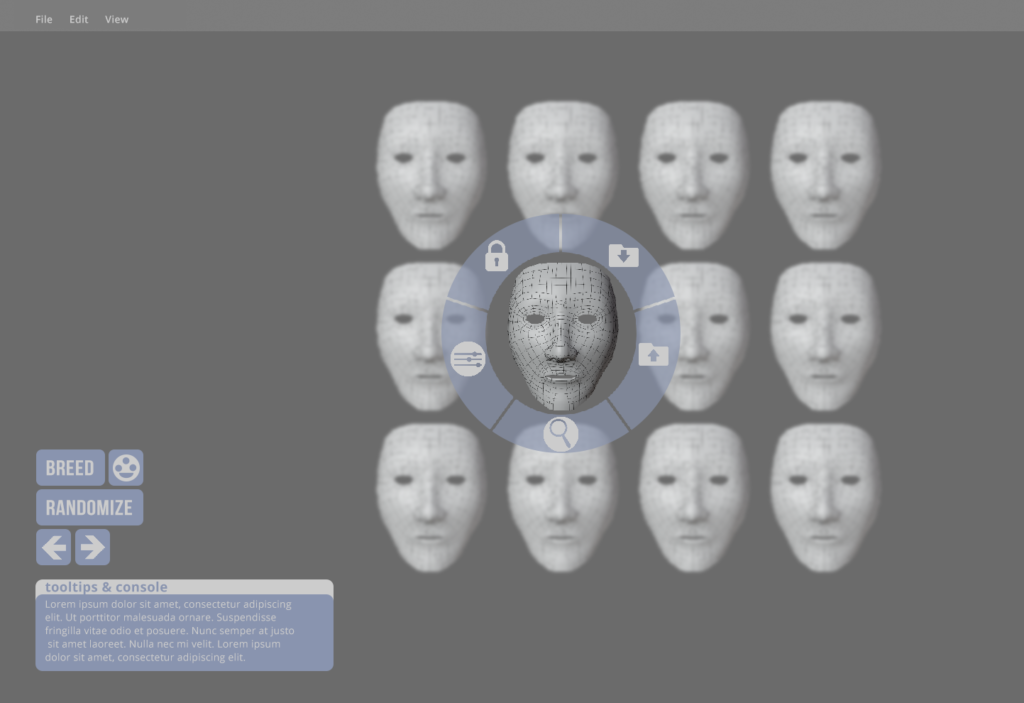
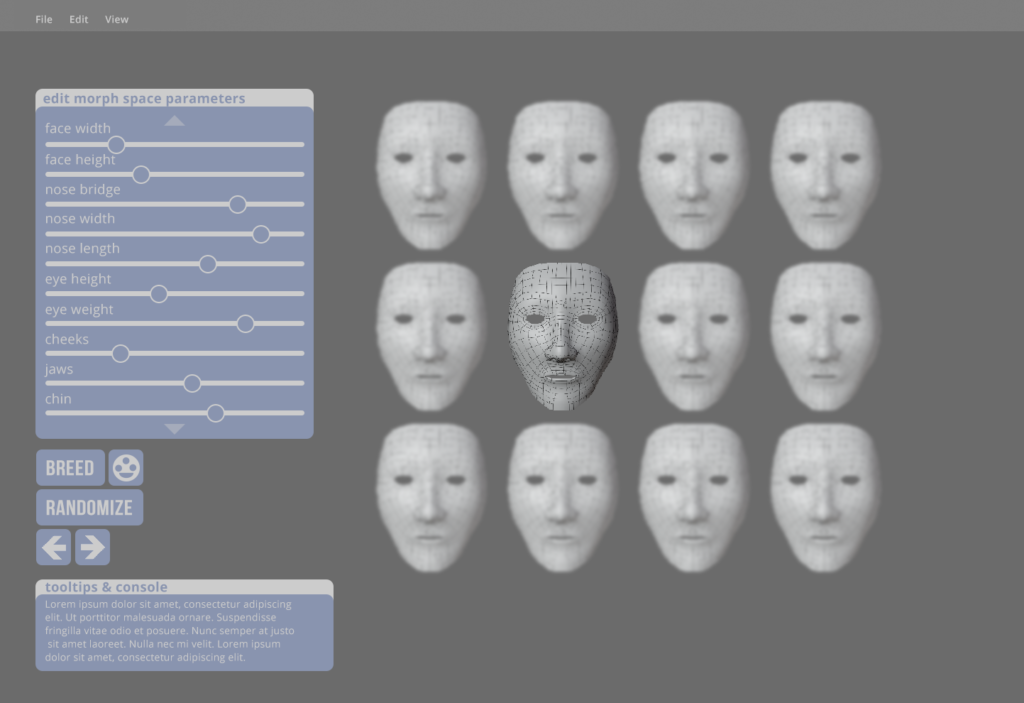
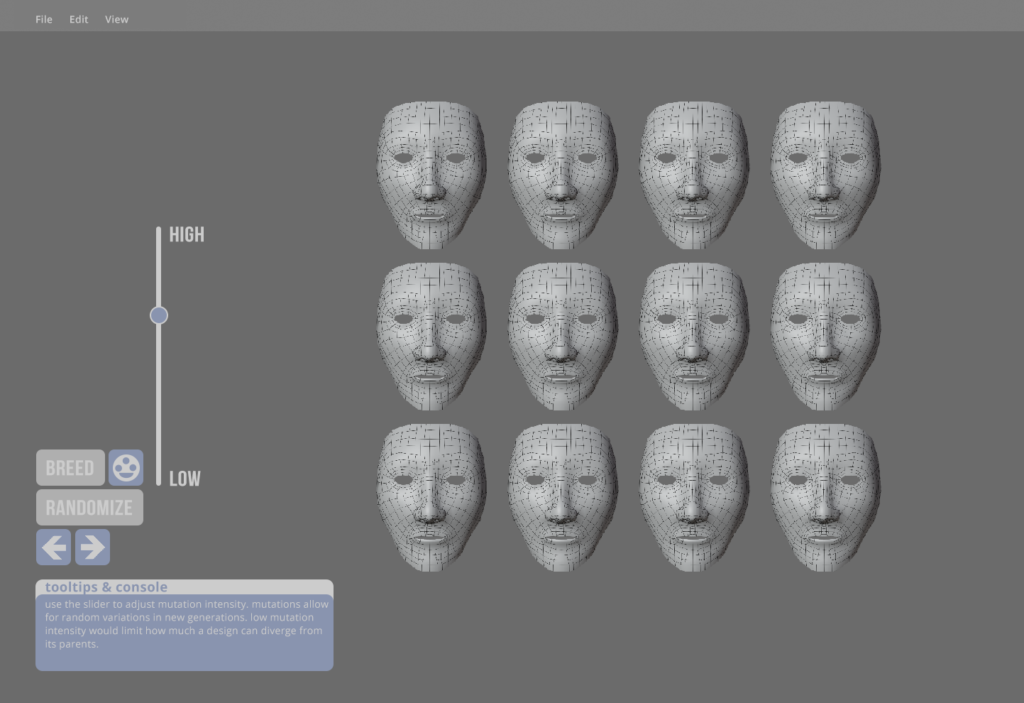
Captures from the w.i.p. application
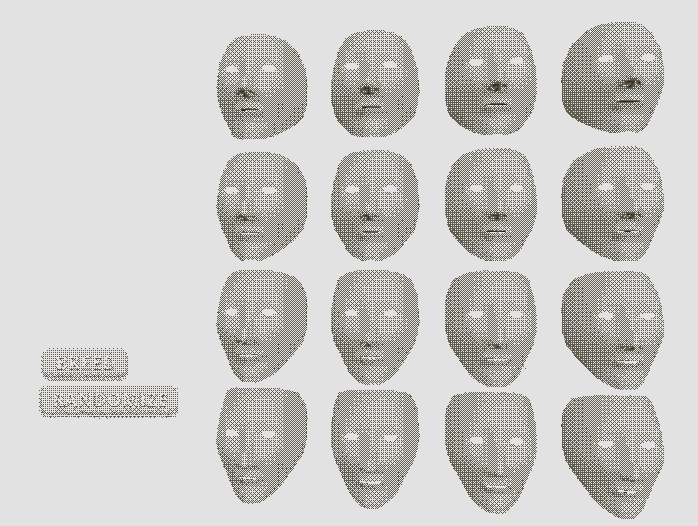
- Create random seed to generate initial designs
- Choose designs to evolve features from
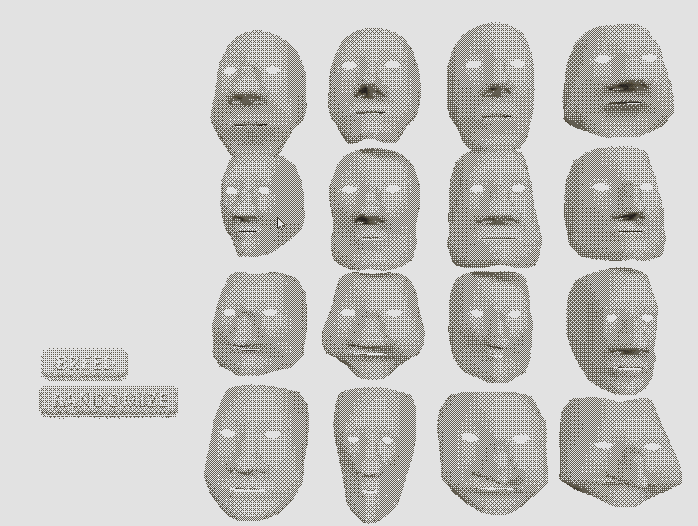
- Evolve new populatiAons from selected faces
- Apply mutations/random deviations
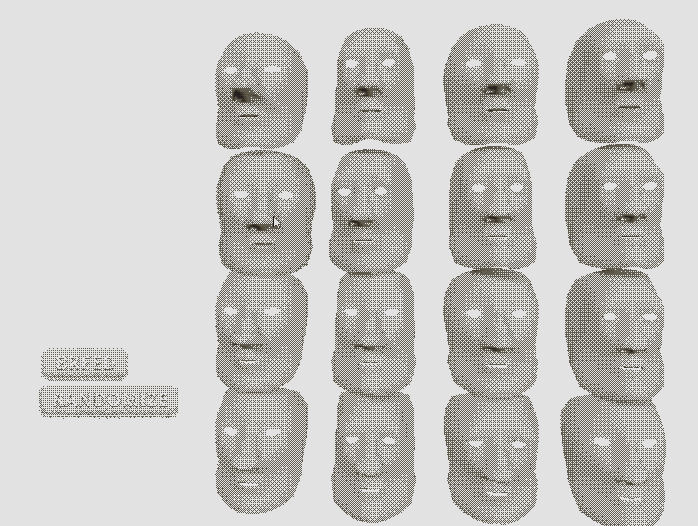
- Isolate and focus on a single solution for fine tuning
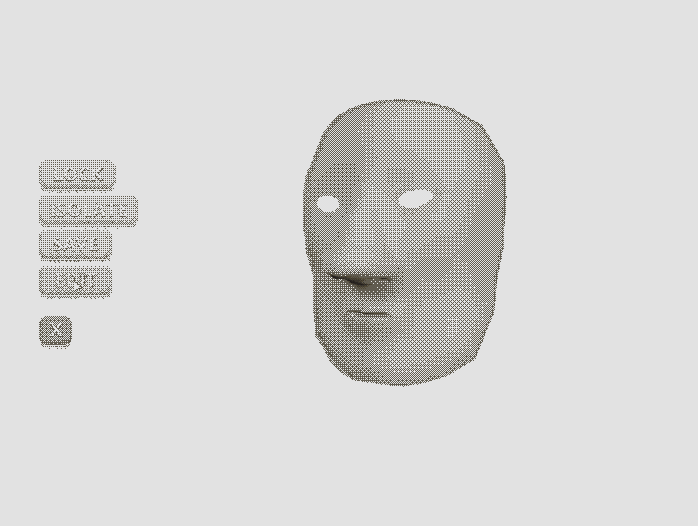
- Fine tune a design focusing on individual features
- Breed, randomize or further fine tune a design until design goals are met
Bibliography (so far)
Creative Evolutionary Systems
- McCormack, Jon. “Artificial Ecosystems for Creative Discovery.” Proceedings of the 9th Annual Conference on Genetic and Evolutionary Computation, ACM, 2007, pp. 301–307. ACM Digital Library, doi:10.1145/1276958.1277017.
- McCormack, Jon. “Facing the future: Evolutionary possibilities for human-machine creativity.” The Art of Artificial Evolution. Springer, Berlin, Heidelberg, 2008. 417-451.
- Sims, Karl. “Artificial Evolution for Computer Graphics.” Proceedings of the 18th Annual Conference on Computer Graphics and Interactive Techniques, ACM, 1991, pp. 319–328. ACM Digital Library, doi:10.1145/122718.122752.
- Sims, K. The Visual Computer (1993) 9: 466. https://doi.org/10.1007/BF01888721
- Clune, Jeff, and Hod Lipson. “Evolving 3D Objects with a Generative Encoding Inspired by Developmental Biology.” SIGEVOlution, vol. 5, no. 4, Nov. 2011, pp. 2–12. ACM Digital Library, doi:10.1145/2078245.2078246.
- Quiroz, Juan C., Amit Banerjee, and Sushil J. Louis. “3-D modeling using collaborative evolution.” Proceedings of the 14th annual conference companion on Genetic and evolutionary computation. ACM, 2012.
- Graf, Jeanine, and Wolfgang Banzhaf. “Interactive Evolution of Images.” Evolutionary Programming. 1995.
- Liapis, Antonios. “Piecemeal Evolution of a First Person Shooter Level.” Applications of Evolutionary Computation, Springer, Cham, 2018, pp. 275–91. link.springer.com, doi:10.1007/978-3-319-77538-8_20.
- Gravina, Daniele, et al. “Coupling Novelty and Surprise for Evolutionary Divergence.” Proceedings of the Genetic and Evolutionary Computation Conference, ACM, 2017, pp. 107–114. ACM Digital Library, doi:10.1145/3071178.3071179.
- Quiroz, Juan C., and Sergiu M. Dascalu. “Interactive Shape Perturbation.” arXiv preprint arXiv:1706.04077 (2017).
- Howlett, Andrew, Simon Colton, and Cameron Browne. “Evolving pixel shaders for the prototype video game subversion.” Proceedings of AISB. Vol. 10. 2010.
- Kiptiah binti Ariffin M., Hadi S., Phon-Amnuaisuk S. (2017) Evolving 3D Models Using Interactive Genetic Algorithms and L-Systems. In: Phon-Amnuaisuk S., Ang SP., Lee SY. (eds) Multi-disciplinary Trends in Artificial Intelligence. MIWAI 2017. Lecture Notes in Computer Science, vol 10607. Springer, Cham
- Lehman, Joel & Clune, Jeff & Misevic, Dusan & Adami, Christoph & Beaulieu, Julie & Bentley, Peter & Bernard, Samuel & Beslon, Guillaume & M. Bryson, David & Cheney, Nick & Cully, Antoine & Donciuex, Stephane & C. Dyer, Fred & Ellefsen, Kai Olav & Feldt, Robert & Fischer, Stephan & Forrest, Stephanie & Frénoy, Antoine & Gagneé, Christian & Yosinksi, Jason. (2018). The Surprising Creativity of Digital Evolution: A Collection of Anecdotes from the Evolutionary Computation and Artificial Life Research Communities.
- Kelly, Jarod C., Gregory H. Wakefield, and Panos Y. Papalambros. “Evidence for using Interactive Genetic Algorithms in shape preference assessment.” International Journal of Product Development 13.2 (2011): 168-184.
- Kán, Peter, and Hannes Kaufmann. “Automated interior design using a genetic algorithm.” Proceedings of the 23rd ACM Symposium on Virtual Reality Software and Technology. ACM, 2017.
- DiPaola, Steve, and Liane Gabora. “Incorporating Characteristics of Human Creativity into an Evolutionary Art Algorithm.” Genetic Programming and Evolvable Machines, vol. 10, no. 2, June 2009, pp. 97–110. link.springer.com, doi:10.1007/s10710-008-9074-x.
- DiPaola, Steve, and Nathan Sorenson. “CGP, Creativity and Art.” Cartesian Genetic Programming, Springer, Berlin, Heidelberg, 2011, pp. 293–307. link.springer.com, doi:10.1007/978-3-642-17310-3_10.
- DiPaola, S.; McCaig, G.; Carlson, K.; Salevati, S.; and Sorenson, N. 2013. Adaptation of an autonomous creative evolutionary system for real-world design application based on creative cognition. In Proceedings of the Fourth International Conference on Computational Creativity
- Norton, David, et al. “Finding Creativity in an Artificial Artist.” The Journal of Creative Behavior, vol. 47, no. 2, June 2013, pp. 106–24. Wiley Online Library, doi:10.1002/jocb.27.
Creative Cognition
- Finke, Ronald A., Thomas B. Ward, and Steven M. Smith. “Creative cognition: Theory, research, and applications.” (1992).
- Boden, Margaret A. “Computer Models of Creativity.” AI Magazine, vol. 30, no. 3, July 2009, p. 23. www.aaai.org, doi:10.1609/aimag.v30i3.2254.
- Silvia, Paul J., Christopher Martin, and Emily C. Nusbaum. “A snapshot of creativity: Evaluating a quick and simple method for assessing divergent thinking.” Thinking Skills and Creativity 4.2 (2009): 79-85.
- Lehman J, Stanley KO (2012) Beyond open-endedness: quantifying impressiveness. ALIFE XIII, pp 75–82
- Colton, Simon. “Creativity Versus the Perception of Creativity in Computational Systems.” AAAI spring symposium: creative intelligent systems. Vol. 8. 2008.
- Gabora, L. (2000). The beer can theory of creativity. In P. Bentley & D. Corne (Eds.) Creative Evolutionary Systems (pp. 147-161). San Francisco: Morgan Kauffman
- Gabora, L., and DiPaola, S. 2012. How did humans become so creative? Proceedings of the International Conference on Computational Creativity, 203-210. May 31 – June 1, Dublin, Ireland.
- Finke, R. A. Imagery, creativity, and emergent structure. Consciousness and cognition, 5(3):381–393, 1996.
- Csikszentmihalyi, M. (1996), Creativity: Flow and the Psychology of Discovery and Invention, New York: Harper
- Csikszentmihalyi, M. Flow: The Psychology of Optimal Experience. 2007 edition, Harper Perennial Modern Classics, 2008.
- Cosmelli, Diego, and David D. Preiss. “On the Temporality of Creative Insight: A Psychological and Phenomenological Perspective.” Frontiers in Psychology, vol. 5, 2014. Frontiers, doi:10.3389/fpsyg.2014.01184.
- Gabora, L. Cognitive mechanisms underlying the creative process. In Proc. of the 4th Conf. on Creativity and Cognition, pages 126–133. ACM Press, 2002.
- Simonton, Dean Keith. “Creativity as Blind Variation and Selective Retention: Is the Creative Process Darwinian?” Psychological Inquiry, vol. 10, no. 4, 1999, pp. 309–28. APA PsycNET, doi:10.1207/S15327965PLI1004_4.
- Cohen-Or, Daniel, and Hao Zhang. “From Inspired Modeling to Creative Modeling.” The Visual Computer, vol. 32, no. 1, Jan. 2016, pp. 7–14. Springer Link, doi:10.1007/s00371-015-1193-9.
- Sternberg, Robert J. “The Nature of Creativity.” Creativity Research Journal, vol. 18, no. 1, Jan. 2006, pp. 87–98. Taylor and Francis+NEJM, doi:10.1207/s15326934crj1801_10.
Creativity Support Tools
- Shneiderman, Ben. “Supporting Creativity with Advanced Information- Abundant User Interfaces.” Frontiers of Human-Centered Computing, Online Communities and Virtual Environments, edited by Rae A. Earnshaw et al., Springer London, 2001, pp. 469–80. Springer Link, doi:10.1007/978-1-4471-0259-5_34.
- Shneiderman, Ben. “Creativity support tools: Accelerating discovery and innovation.” Communications of the ACM 50.12 (2007): 20-32.
- Shneiderman, B. Creativity support tools: A grand challenge for HCI researchers. In Miguel Redondo, Crescencio Bravo, and Manuel Ortega, editors, Engineering The User Interface, pages 1–9. Springer-Verlag London Limited, 2009
- Resnick, Mitchel, et al. “Design principles for tools to support creative thinking.” NSF Workshop Report on Creativity Support Tools. 2005.
- Antonios Liapis and Georgios N. Yannakakis. Boosting computational creativity with human interaction in mixed-initiative co-creation tasks. In Proceedings of the ICCC workshop on Computational Creativity and Games, 2016
- Liapis, A., Yannakakis, G.N., Alexopoulos, C., Lopes, P.: Can computers foster human users’ creativity? Theory and praxis of mixed-initiative co-creativity. Digital Culture & Education 8(2), 136–153 (2016)
- Kantosalo, A.; Toivanen, J. M.; Xiao, P.; and Toivonen, H. 2014. From isolation to involvement: Adapting machine creativity software to support human-computer co-creation. In Proceedings of the International Conference on Computational Creativity.
- Kantosalo, Anna, and Hannu Toivonen. “Modes for creative human-computer collaboration: Alternating and task-divided co-creativity.” Proceedings of the Seventh International Conference on Computational Creativity. 2016.
- Yamamoto, Yasuhiro, and Kumiyo Nakakoji. “Interaction design of tools for fostering creativity in the early stages of information design.” International Journal of Human-Computer Studies 63.4-5 (2005): 513-535.
- Bown, O. 2014. Empirically grounding the evaluation of creative systems: Incorporating interaction design. In Proceedings of the Fifth International Conference on Computational Creativity, 112–119.
- Kantosalo, A.; Toivanen, J. M.; and Toivonen, H. 2015. Interaction evaluation for human-computer co-creativity: A case study. In Proceedings of the International Conference on Computational Creativity.
- Compton, K., and Mateas, M. 2015. Casual creators. In Proceedings of the International Conference on Computational Creativity.
- Jennings, Pamela, and Elisa Giaccardi. “Creativity support tools for and by the new media arts community.” NSF Workshop Report on Creativity Support Tools. 2005.
- Lubart, Todd. “How can computers be partners in the creative process: classification and commentary on the special issue.” International Journal of Human-Computer Studies 63.4-5 (2005): 365-369.
- Edmonds, Ernest A., et al. “The studio as laboratory: combining creative practice and digital technology research.” International Journal of Human-Computer Studies 63.4-5 (2005): 452-481.
- Candy, Linda, and Koichi Hori. “The digital muse: HCI in support of creativity: creativity and cognition comes of age: towards a new discipline.” interactions 10.4 (2003): 44-54.
- Eales, R. T. “Creativity in action: some implications for the design of creativity support systems.” Proceedings of the 6th ACM SIGCHI New Zealand chapter’s international conference on Computer-human interaction: making CHI natural. ACM, 2005.
- Candy, Linda, and Ernest A. Edmonds. “Supporting the creative user: a criteria-based approach to interaction design.” Design Studies 18.2 (1997): 185-194.
- Hutchins, Edwin L., et al. “Direct Manipulation Interfaces.” Hum.-Comput. Interact., vol. 1, no. 4, Dec. 1985, pp. 311–338. ACM Digital Library, doi:10.1207/s15327051hci0104_2.
- Cherry, Erin, and Celine Latulipe. “Quantifying the Creativity Support of Digital Tools Through the Creativity Support Index.” ACM Trans. Comput.-Hum. Interact., vol. 21, no. 4, June 2014, pp. 21:1–21:25. ACM Digital Library, doi:10.1145/2617588.
3D Graphics
- Ebert, David S., et al. Texturing & modeling: a procedural approach. Morgan Kaufmann, 1994.
- Chaudhuri, Siddhartha, and Vladlen Koltun. “Data-Driven Suggestions for Creativity Support in 3D Modeling.” ACM SIGGRAPH Asia 2010 Papers, ACM, 2010, pp. 183:1–183:10. ACM Digital Library, doi:10.1145/1866158.1866205.
- Verstijnen, Ilse M., et al. “Sketching and creative discovery.” Design studies 19.4 (1998): 519-546.
- Kazi, Rubaiat Habib, et al. “DreamSketch: Early Stage 3D Design Explorations with Sketching and Generative Design.” UIST. 2017.
- Andre, Alexis, and Suguru Saito. “Single-view sketch based modeling.” Proceedings of the Eighth Eurographics Symposium on Sketch-Based Interfaces and Modeling. ACM, 2011.
- Lun, Zhaoliang, Evangelos Kalogerakis, and Alla Sheffer. “Elements of style: learning perceptual shape style similarity.” ACM Transactions on Graphics (TOG) 34.4 (2015): 84.
- Ma, Chongyang, et al. “Analogy‐driven 3D style transfer.” Computer Graphics Forum. Vol. 33. No. 2. 2014.
- Olsen, Luke, et al. “Sketch-based modeling: A survey.” Computers & Graphics 33.1 (2009): 85-103.
- Jones, Mark W., J. Andreas Baerentzen, and Milos Sramek. “3D distance fields: A survey of techniques and applications.” IEEE Transactions on visualization and Computer Graphics12.4 (2006): 581-599.
- Havemann, Sven, and Dieter W. Fellner. “Generative mesh modeling.” (2005): 4.
- Kähler, Kolja, et al. “Head Shop: Generating Animated Head Models with Anatomical Structure.” Proceedings of the 2002 ACM SIGGRAPH/Eurographics Symposium on Computer Animation, ACM, 2002, pp. 55–63. ACM Digital Library, doi:10.1145/545261.545271.
- Torres, Cesar, and Eric Paulos. “MetaMorphe: Designing expressive 3D models for digital fabrication.” Proceedings of the 2015 ACM SIGCHI Conference on Creativity and Cognition. ACM, 2015.
- Talton, Jerry O., et al. “Exploratory Modeling with Collaborative Design Spaces.” ACM SIGGRAPH Asia 2009 Papers, ACM, 2009, pp. 167:1–167:10. ACM Digital Library, doi:10.1145/1661412.1618513.
- Marks, Joe, et al. “Design Galleries: A General Approach to Setting Parameters for Computer Graphics and Animation.” Proceedings of SIGGRAPH, 1997. dash.harvard.edu, doi:10.1145/258734.258887.
- Guo, Xuekun, et al. “Creature Grammar for Creative Modeling of 3D Monsters.” Graphical Models, vol. 76, no. 5, Sept. 2014, pp. 376–89. ScienceDirect, doi:10.1016/j.gmod.2014.03.019.
- Xu, Kai, et al. “Fit and Diverse: Set Evolution for Inspiring 3D Shape Galleries.” ACM Trans. Graph., vol. 31, no. 4, July 2012, pp. 57:1–57:10. ACM Digital Library, doi:10.1145/2185520.2185553.
- Kim, Vladimir G., et al. “Exploring Collections of 3D Models Using Fuzzy Correspondences.” ACM Trans. Graph., vol. 31, no. 4, July 2012, pp. 54:1–54:11. ACM Digital Library, doi:10.1145/2185520.2185550.
- Funkhouser, Thomas, et al. “Modeling by Example.” ACM SIGGRAPH 2004 Papers, ACM, 2004, pp. 652–663. ACM Digital Library, doi:10.1145/1186562.1015775.
- Sloan, Peter-Pike J., et al. “Shape by Example.” Proceedings of the 2001 Symposium on Interactive 3D Graphics, ACM, 2001, pp. 135–143. ACM Digital Library, doi:10.1145/364338.364382.
Face Perception
- Burleigh, Tyler J., et al. “Does the Uncanny Valley Exist? An Empirical Test of the Relationship between Eeriness and the Human Likeness of Digitally Created Faces.” Computers in Human Behavior, vol. 29, no. 3, May 2013, pp. 759–71. ScienceDirect, doi:10.1016/j.chb.2012.11.021.
- Carter, Elizabeth J., et al. “Unpleasantness of Animated Characters Corresponds to Increased Viewer Attention to Faces.” Proceedings of the ACM Symposium on Applied Perception, ACM, 2013, pp. 35–40. ACM Digital Library, doi:10.1145/2492494.2502059.
- Dill, Vanderson, et al. “Evaluation of the Uncanny Valley in CG Characters.” Intelligent Virtual Agents, edited by Yukiko Nakano et al., Springer Berlin Heidelberg, 2012, pp. 511–13.
- Ferstl, Ylva, and Rachel McDonnell. “A Perceptual Study on the Manipulation of Facial Features for Trait Portrayal in Virtual Agents.” Proceedings of the 18th International Conference on Intelligent Virtual Agents, ACM, 2018, pp. 281–288. ACM Digital Library, doi:10.1145/3267851.3267891.
- Gold, Jason M., et al. “The Perception of a Face Is No More Than the Sum of Its Parts.” Psychological Science, vol. 23, no. 4, Apr. 2012, pp. 427–34. SAGE Journals, doi:10.1177/0956797611427407.
- Gratch, J., et al. “Creating Interactive Virtual Humans: Some Assembly Required.” IEEE Intelligent Systems, vol. 17, no. 4, July 2002, pp. 54–63. IEEE Xplore, doi:10.1109/MIS.2002.1024753.
- Lee, Sooha Park, et al. “Eyes Alive.” Proceedings of the 29th Annual Conference on Computer Graphics and Interactive Techniques, ACM, 2002, pp. 637–644. ACM Digital Library, doi:10.1145/566570.566629.
- McDonnell, Rachel. “Appealing Virtual Humans.” Motion in Games, edited by Marcelo Kallmann and Kostas Bekris, Springer Berlin Heidelberg, 2012, pp. 102–11.
- McDonnell, Rachel, et al. “Render Me Real?: Investigating the Effect of Render Style on the Perception of Animated Virtual Humans.” ACM Trans. Graph., vol. 31, no. 4, July 2012, pp. 91:1–91:11. ACM Digital Library, doi:10.1145/2185520.2185587.
- MacDorman, Karl F., and Hiroshi Ishiguro. “The Uncanny Advantage of Using Androids in Cognitive and Social Science Research.” Interaction Studies, vol. 7, no. 3, Jan. 2006, pp. 297–337. www.jbe-platform.com, doi:10.1075/is.7.3.03mac.
- Mustafa, Maryam, and Marcus Magnor. “EEG Based Analysis of the Perception of Computer-Generated Faces.” Proceedings of the 13th European Conference on Visual Media Production (CVMP 2016), ACM, 2016, pp. 4:1–4:10. ACM Digital Library, doi:10.1145/2998559.2998563.
- Rakover, Sam S. “Featural vs. Configurational Information in Faces: A Conceptual and Empirical Analysis.” British Journal of Psychology, vol. 93, no. 1, Feb. 2002, pp. 1–30. onlinelibrary.wiley.com, doi:10.1348/000712602162427.
- Young, Andrew W., et al. “Configurational Information in Face Perception.” Perception, vol. 42, no. 11, Nov. 2013, pp. 1166–78. SAGE Journals, doi:10.1068/p160747n.
- Zell, Eduard, and Mario Botsch. “ElastiFace: Matching and Blending Textured Faces.” Proceedings of the Symposium on Non-Photorealistic Animation and Rendering, ACM, 2013, pp. 15–24. ACM Digital Library, doi:10.1145/2486042.2486045.
- Zell, Eduard, et al. “To Stylize or Not to Stylize?: The Effect of Shape and Material Stylization on the Perception of Computer-Generated Faces.” ACM Trans. Graph., vol. 34, no. 6, Oct. 2015, pp. 184:1–184:12. ACM Digital Library, doi:10.1145/2816795.2818126.
- DiPaola, Steve. “Exploring a Parameterized Portrait Painting Space”, International Journal of Art and Technology, Vol 2, No 1-2, pp 82-93, 2009 summit.sfu.ca, http://summit.sfu.ca/item/56.
- Anderson, Nicole D., and Hugh R. Wilson. “The Nature of Synthetic Face Adaptation.” Vision Research, vol. 45, no. 14, June 2005, pp. 1815–28. ScienceDirect, doi:10.1016/j.visres.2005.01.012.
- Rhodes, Gillian, et al. “Fitting the Mind to the World: Face Adaptation and Attractiveness Aftereffects.” Psychological Science, vol. 14, no. 6, Nov. 2003, pp. 558–66. SAGE Journals, doi:10.1046/j.0956-7976.2003.psci_1465.x.
- Webster, Michael A., and Otto H. Maclin. “Figural After effects in the Perception of Faces.” Psychonomic Bulletin & Review, vol. 6, no. 4, Dec. 1999, pp. 647–53. Springer Link, doi:10.3758/BF03212974.
- Leopold, David A., et al. “Prototype-Referenced Shape Encoding Revealed by High-Level Aftereffects.” Nature Neuroscience, vol. 4, no. 1, Jan. 2001, pp. 89–94. www.nature.com, doi:10.1038/82947.
- Stirrat, M., and D. I. Perrett. “Valid Facial Cues to Cooperation and Trust: Male Facial Width and Trustworthiness.” Psychological Science, vol. 21, no. 3, Mar. 2010, pp. 349–54. SAGE Journals, doi:10.1177/0956797610362647.
- Oosterhof, Nikolaas N., and Alexander Todorov. “The Functional Basis of Face Evaluation.” Proceedings of the National Academy of Sciences, vol. 105, no. 32, Aug. 2008, pp. 11087–92. www.pnas.org, doi:10.1073/pnas.0805664105.